The Amethyst-throated Mountain Gem (Lampornis amethystinus) stands as a jewel among the hummingbirds, adorning the cloud forests of Central America with its vibrant plumage and enchanting presence.
Renowned for the resplendent amethyst and violet hues that adorn the throats of the males, this species captures the essence of high-altitude elegance.
Inhabiting elevations ranging from 1,200 to 2,400 meters, the Amethyst-throated Mountain Gem navigates the misty realms of Costa Rica and western Panama with agile grace.
Its slender frame and rapid wing beats, reaching up to 80 beats per second, mark it as an adept aerial acrobat.
Beyond its visual allure, this hummingbird plays a crucial role in pollination, forming symbiotic relationships with the diverse flora of its cloud forest habitat.
As we delve into the world of the Amethyst-throated Mountain Gem, we unravel a tapestry woven with intricate behaviors, ecological significance, and the undeniable beauty that defines this mesmerizing species. Stay sharp.
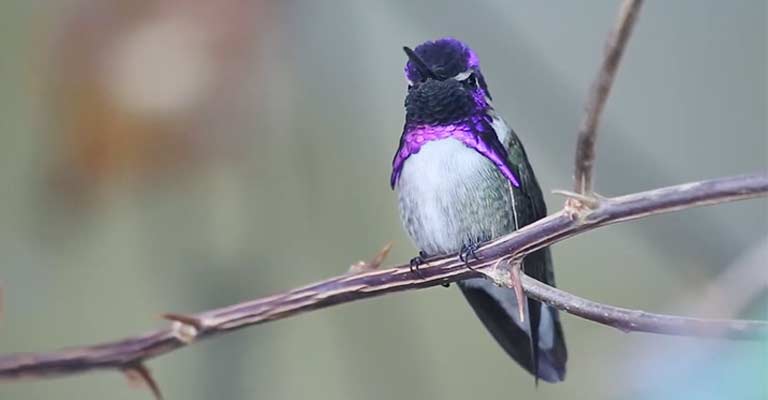
Identifying Characteristics of Amethyst-throated Mountain Gem
The Amethyst-throated Mountain Gem (Lampornis amethystinus) is a stunning and distinctive hummingbird species found in the high-altitude cloud forests of Central America, particularly in regions of Costa Rica and western Panama.
Identifying this bird involves paying attention to several key characteristics that set it apart from other hummingbird species.
Physical Appearance
One of the most striking features of the Amethyst-throated Mountain Gem is its vibrant plumage. The male boasts iridescent, jewel-like feathers that shimmer with hues of amethyst and violet on the throat, giving the bird its name.
The upperparts are typically a brilliant green, creating a beautiful contrast with the striking throat color. The females, on the other hand, lack the iridescent throat and usually exhibit more subdued green plumage.
Size and Shape
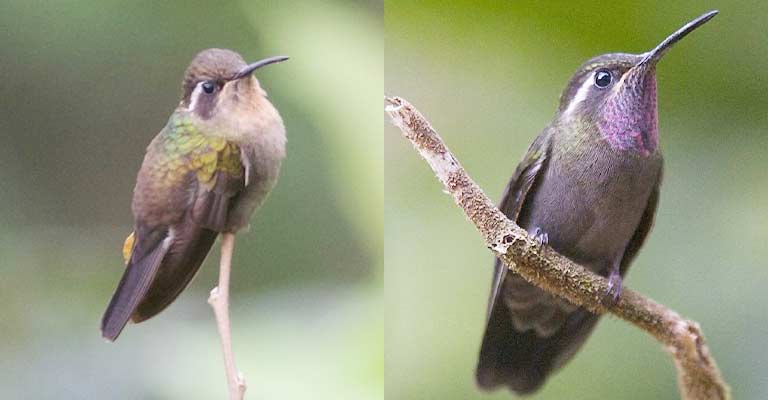
Measuring around 10 to 11 centimeters in length, the Amethyst-throated Mountain Gem is a relatively small hummingbird.
Its slender body and long, straight bill are characteristic of hummingbirds, allowing them to feed on nectar from flowers with precision. The tail is often slightly forked, adding to its distinctive silhouette in flight.
Behavior and Flight Pattern
Observing the flight pattern of the Amethyst-throated Mountain Gem is crucial for identification. These hummingbirds are agile fliers, capable of rapid and intricate maneuvers.
They are often seen hovering near flowers, extracting nectar with their specialized bills.
Their flight is accompanied by a distinctive humming sound created by the rapid beating of their wings, which can reach up to 80 beats per second.
Habitat and Range
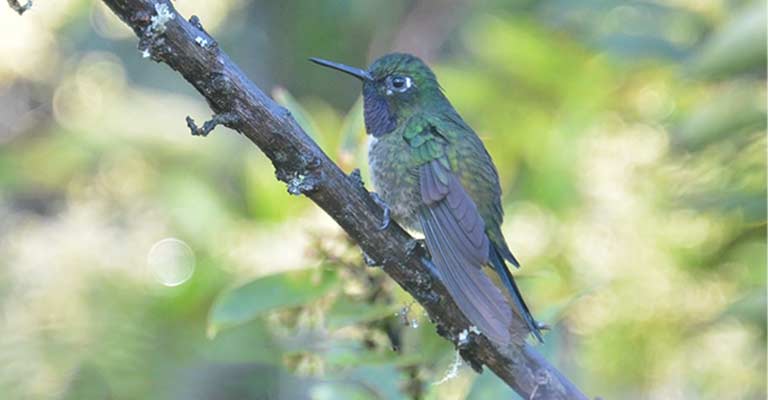
This species is primarily found in montane cloud forests, preferring altitudes between 1,200 to 2,400 meters.
Understanding their habitat preferences is essential for birdwatchers seeking to identify the Amethyst-throated Mountain Gem.
These birds are often associated with lush, misty environments, where they can find a variety of nectar-rich flowers for sustenance.
Vocalizations
While visual cues are crucial for identification, the vocalizations of the Amethyst-throated Mountain Gem can also aid in distinguishing it from other hummingbirds.
The male’s territorial and courtship songs include a series of high-pitched chirps and trills. Familiarizing oneself with these distinctive vocalizations can be a valuable tool for birdwatchers.
Mating and Nesting Behavior
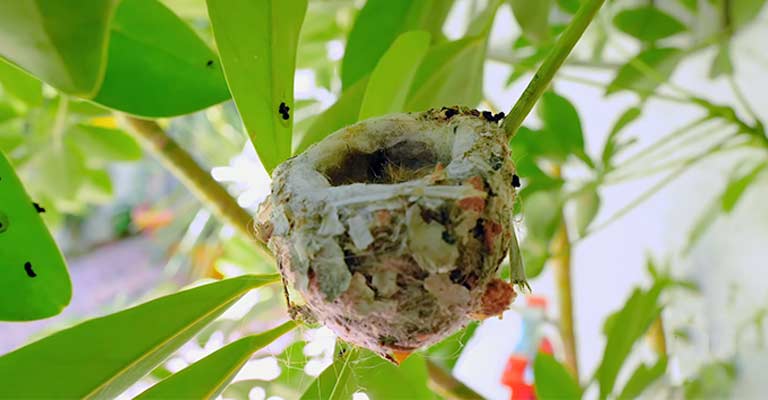
During the breeding season, male Amethyst-throated Mountain Gems engage in elaborate courtship displays to attract females. Understanding these behaviors, such as aerial displays and vocalizations, can be integral to identification.
Females are responsible for building cup-shaped nests, usually located on high, horizontal branches, incorporating moss and lichens for camouflage.
Identifying the Amethyst-throated Mountain Gem requires a combination of visual and auditory observations.
A keen eye for its vibrant plumage, flight patterns, habitat preferences, and distinctive behaviors will enhance the birdwatcher’s ability to recognize and appreciate this magnificent hummingbird species in its natural environment.
Taxonomy of Amethyst-throated Mountain Gem
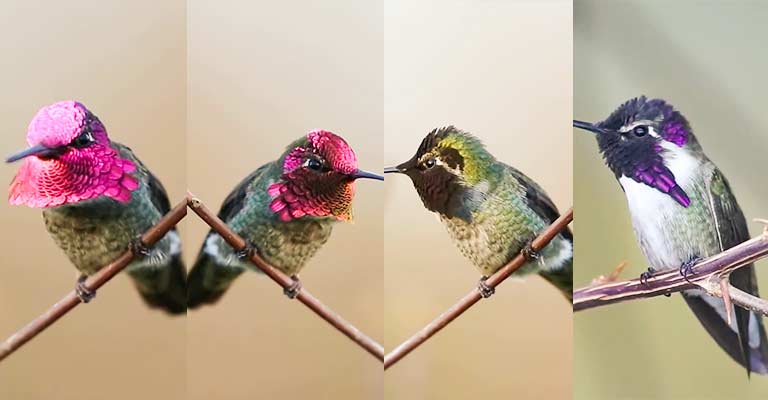
Here’s a table summarizing the taxonomy details of the Amethyst-throated Mountain Gem:
| Taxonomic Rank | Classification |
| Domain | Eukaryota |
| Kingdom | Animalia |
| Phylum | Chordata |
| Class | Aves |
| Clade | Strisores |
| Order | Apodiformes |
| Family | Trochilidae |
| Genus | Lampornis |
| Species | L. amethystinus |
This table outlines the hierarchical classification of the Amethyst-throated Mountain Gem within the broader context of the biological taxonomy system.
From its position in the animal kingdom down to its specific species name, each rank provides a clearer understanding of the bird’s taxonomic placement.
The Amethyst-throated Mountain Gem (Lampornis amethystinus) exhibits fascinating diversity through its various subspecies, each adapted to specific regions within its range.
Here’s an overview of the distinctive characteristics of the Similar species:
L. a. amethystinus (Swainson, 1827)
The nominate subspecies, found in the core range of the species, boasts the signature amethyst and violet throat plumage that defines the Amethyst-throated Mountain Gem. Its distribution spans the cloud forests of Costa Rica and western Panama.
L. a. margaritae (Salvin & Godman, 1889)
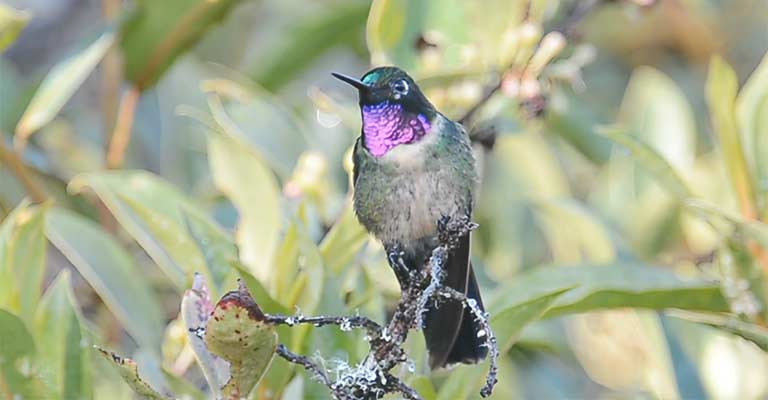
Identified by ornithologists Salvin and Godman, this subspecies is named after its pearl-like throat coloring. It inhabits specific regions within the broader range, contributing to the overall genetic diversity and adaptability of the Amethyst-throated Mountain Gem.
L. a. circumventris (A.R. Phillips, 1966)
Described by Phillips, this subspecies is characterized by unique features that distinguish it within the Amethyst-throated Mountain Gem family. Its specific adaptations reflect the nuances of the ecological niches it occupies.
L. a. salvini (Ridgway, 1908)
Named in honor of ornithologist Osbert Salvin, this subspecies exhibits variations in plumage and possibly subtle differences in behavior or ecology. Studying L. a. salvini contributes to a comprehensive understanding of the species.
L. a. nobilis (Griscom, 1932)
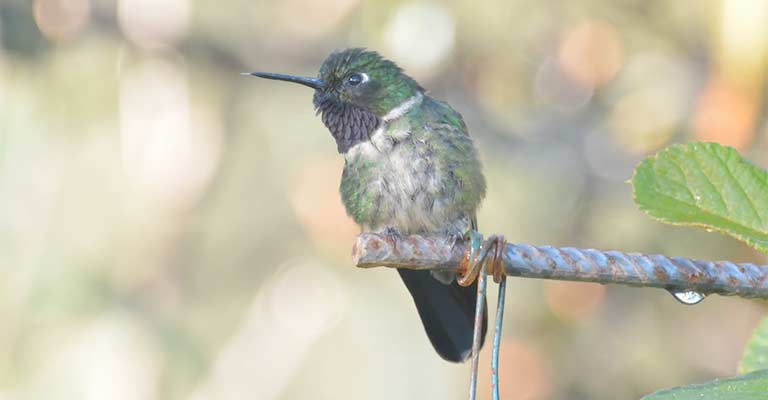
Griscom’s description captures the regal essence of this subspecies. Notable for its unique attributes, L. a. nobilis enriches the overall biodiversity of the Amethyst-throated Mountain Gem population.
These subspecies showcase the dynamic nature of the Amethyst-throated Mountain Gem, reflecting adaptations to specific environments and contributing to the species’ overall resilience.
Amethyst-throated Mountain Gem Life History
The Amethyst-throated Mountain Gem (Lampornis amethystinus) unveils a captivating life history intricately woven into the tapestry of Central American cloud forests.
As a jewel of the avian world, this hummingbird species enchants observers with its vibrant plumage and fascinating life cycle.
From foraging on nectar-rich blossoms to engaging in intricate courtship rituals, the Amethyst-throated Mountain Gem’s life history unfolds against the backdrop of misty montane landscapes.
Food
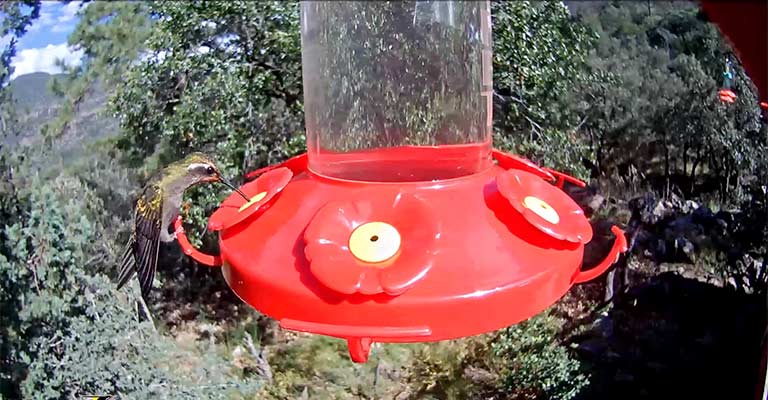
The primary dietary focus of the Amethyst-throated Mountain Gem centers around nectar obtained from a diverse array of flowering plants.
With their specialized bills and long, extensible tongues, these hummingbirds extract nectar with precision.
While nectar serves as their main energy source, they supplement their diet with small insects and spiders, providing essential proteins and nutrients crucial for their overall health.
Habitat
The Amethyst-throated Mountain Gem thrives in the high-altitude cloud forests, typically found at elevations ranging from 1,200 to 2,400 meters.
These misty environments provide the ideal conditions for an abundance of flowering plants, ensuring a consistent nectar supply for the hummingbirds.
Their habitat preference underscores the importance of preserving these unique ecosystems to safeguard the species.
Range Map

The range of the Amethyst-throated Mountain Gem spans the cloud forests of Costa Rica and western Panama.
A range map can visually depict the specific areas where these hummingbirds are distributed, emphasizing the need for conservation efforts in these regions to protect their habitats and ensure the species’ survival.
Nesting
Females of the species are responsible for constructing cup-shaped nests typically situated on high, horizontal branches.
Moss and lichens are intricately woven into the nest’s structure, providing camouflage and protection for the eggs and chicks.
The meticulous nest-building process is a testament to the bird’s adaptability to its surroundings.
Here’s a table summarizing the nesting details of the Amethyst-throated Mountain Gem:
| Nesting Details | Facts |
| Clutch Size | Typically 2 eggs |
| Number of Broods | Usually raises one brood per season |
| Egg Length | Approximately 1.5 centimeters |
| Egg Width | Around 1 centimeter |
| Incubation Period | Approximately 15 to 18 days |
| Nestling Period | About 20 to 25 days |
| Egg Description | Tiny, white, or creamy in color, with a slightly elongated shape |
| Nest Construction | Cup-shaped, woven with moss and lichens, often placed on high, horizontal branches |
| Incubation Responsibility | Female incubates the eggs alone |
| Parental Care | Both parents contribute to feeding and caring for the nestlings |
| Nestling Development | Chicks are altricial, relying on parental care for an extended period |
| Nesting Habitat | Typically located in the canopy of montane cloud forests |
These nesting details offer insights into the reproductive behaviors and strategies of the Amethyst-throated Mountain Gem, highlighting the intricate processes involved in ensuring the survival and well-being of their offspring.
Breeding
The breeding season marks a period of heightened activity for the Amethyst-throated Mountain Gem.
Males engage in elaborate courtship displays, showcasing their vibrant plumage and executing intricate aerial maneuvers to attract potential mates.
Once paired, females lay two tiny eggs, and the collaborative effort of incubation falls to the female alone.
Diseases
Hummingbirds, including the Amethyst-throated Mountain Gem, can be susceptible to various diseases, including avian malaria and fungal infections.
These ailments can impact their health and reproductive success, highlighting the importance of monitoring and addressing disease outbreaks in wild populations.
Treatment
Efforts to treat diseases in wild hummingbird populations involve a combination of research, monitoring, and, where feasible, intervention.
Conservationists may implement measures such as habitat management, disease surveillance, and public awareness campaigns to mitigate the impact of diseases on the Amethyst-throated Mountain Gem and other hummingbird species.
Conservation
Conserving the Amethyst-throated Mountain Gem requires a multifaceted approach.
Protecting their cloud forest habitats from deforestation, raising awareness about the importance of these ecosystems, and implementing sustainable practices are crucial steps.
Conservation initiatives should also address the potential threats posed by climate change and ensure the preservation of the delicate balance that sustains these enchanting birds in their natural environment.
The life history of the Amethyst-throated Mountain Gem is a testament to the intricate interplay between the species and its habitat.
From foraging and nesting to breeding and conservation, each facet of their existence underscores the importance of preserving the delicate ecosystems that support this jewel of the cloud forests.
10 Fun Facts About Amethyst-throated Mountain Gem
Here are some fun and intriguing facts about the Amethyst-throated Mountain Gem:
- Jewel of the Cloud Forests: The Amethyst-throated Mountain Gem earns its name from the stunning amethyst and violet hues that adorn the throat feathers of the male. This vibrant display makes it a true gem of the cloud forests it inhabits.
- High-Altitude Habitat: Unlike many hummingbird species, the Amethyst-throated Mountain Gem thrives at elevations ranging from 1,200 to 2,400 meters. Its ability to adapt to the cool, misty conditions of high-altitude cloud forests sets it apart from other hummingbirds.
- Meticulous Nest Builders: Female Amethyst-throated Mountain Gems showcase impressive nest-building skills. Using materials like moss and lichens, they create cup-shaped nests, carefully placed on high, horizontal branches to provide security for their eggs and chicks.
- Aerial Acrobats: These hummingbirds are known for their agile and acrobatic flight patterns. Their rapid wing beats, which can reach up to 80 beats per second, enable them to hover near flowers with precision, making them adept at feeding on nectar.
- Elaborate Courtship Displays: During the breeding season, male Amethyst-throated Mountain Gems engage in elaborate courtship displays. These displays include aerial acrobatics, showing off their vibrant plumage, and emitting distinctive vocalizations to attract potential mates.
- Tiny Treasures: The eggs of the Amethyst-throated Mountain Gem are minuscule, measuring only about 1.5 centimeters in length. Despite their small size, these eggs give rise to the next generation of these captivating hummingbirds.
- Symbiotic Relationships: The Amethyst-throated Mountain Gem plays a crucial role in the pollination of many high-altitude flowers in its habitat. As they feed on nectar, their heads come into contact with flower reproductive structures, facilitating the transfer of pollen and supporting plant reproduction.
- Disease Susceptibility: Like many hummingbird species, the Amethyst-throated Mountain Gem can be susceptible to diseases such as avian malaria. Conservation efforts often include monitoring and addressing disease outbreaks to ensure the well-being of wild populations.
- Conservation Concerns: Due to habitat loss caused by deforestation and climate change, the Amethyst-throated Mountain Gem faces conservation challenges. Conservation initiatives aim to protect their cloud forest habitats and raise awareness about the importance of preserving these unique ecosystems.
- Unique Hovering Ability: Hummingbirds, including the Amethyst-throated Mountain Gem, have a remarkable ability to hover in mid-air by rapidly flapping their wings in a figure-eight pattern. This allows them to feed efficiently from flowers.
These fun facts shed light on the fascinating characteristics and behaviors of the Amethyst-throated Mountain Gem, showcasing its role as a captivating and ecologically significant species in the cloud forests of Central America.
Wrapping Up
In the misty heights of Central American cloud forests, the Amethyst-throated Mountain Gem emerges as a jewel of avian beauty and ecological importance.
Its vibrant plumage, intricate nesting habits, and aerial acrobatics weave a captivating narrative of survival in the high-altitude realms.
The species faces challenges, yet its resilience underscores the need for vigilant conservation.
As we marvel at its jewel-like throat and learn about its crucial role in pollination, we are reminded of the delicate balance within these ecosystems.
Preserving the Amethyst-throated Mountain Gem’s habitat becomes not just a responsibility but a pledge to safeguard the magic of the cloud forests for generations to come. Best of luck.